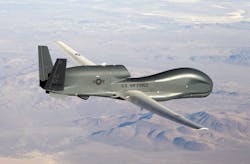Northrop Grumman to upgrade and sustain Air Force Global Hawk long-range UAV fleet in $4.8 billion contract
WRIGHT-PATTERSON AFB, Ohio – Unmanned aerial vehicle (UAV) experts at Northrop Grumman Corp. will upgrade, retrofit, and sustain the U.S. Air Force RQ-4 Global Hawk long-range UAV fleet under terms of a $4.8 billion contract announced last Wednesday.
Officials of the Air Force Life Cycle Management Center at Wright-Patterson Air Force Base, Ohio, are asking the Northrop Grumman Aeronautics Systems segment in San Diego for Global Hawk development, modernization, retrofit and sustainment activities for all Air Force Global Hawk variants.
Global Hawk is a high-altitude, long-range UAV that provides near-real-time intelligence, surveillance and reconnaissance (ISR) over large areas. The Block 30 Global Hawk carries sophisticated imaging and electronic signals sensors on missions that can exceed 32 hours.
This contract provides for technical management; technology refresh; diminishing manufacturing sources; cyber security and information assurance; logistics support; and quality assurance.
Related: Sensor payloads for unmanned vehicles
The Block 30M Global Hawk, one modern variant of the unmanned aircraft, is configured to carry the Raytheon Enhanced Integrated Sensor Suite (EISS) and the Northrop Grumman Airborne Signals Intelligence Payloads (ASIP) for situational awareness and intelligence-gathering across huge areas of land, Northrop Grumman officials say.
The Block 30 Global Hawk with its ISR capabilities is designed to augment or replace the Air Force U-2 high-altitude manned reconnaissance aircraft.
Despite the Global Hawk's formidable surveillance and reconnaissance capabilities, it is vulnerable to anti-aircraft fire. In June 2019 Iran's Islamic Revolutionary Guard Corps shot down a Global Hawk with a surface-to-air missile over the Strait of Hormuz.
The EISS on the Global Hawk provides reconnaissance imagery using an all-weather synthetic aperture radar/moving target indicator (SAR/MTI), a high-resolution electro-optical (EO) digital camera, and a third-generation infrared (IR) sensor, all operating through a common signal processor.
The Raytheon EISS enables Global Hawk to survey vast geographic regions with image quality that can distinguish various types of vehicles, aircraft, people, and missiles, even through bad weather, day or night.
The EISS transmits imagery and position information from altitudes as high as 60,000 feet with near real-time speed with night vision and radar detection capabilities.
The Global Hawk Block 30 is 47.6 feet long, has a wingspan of 130.9 feet, can fly as high as 60,000 feet, can carry payloads as heavy as 3,000 pounds, and can fly for as long as 32 hours on one load of fuel.
On this contract Northrop Grumman will do the work in San Diego, and should be finished by September 2030. For more information contact Northrop Grumman Aeronautics Systems online at www.northropgrumman.com, or the Air Force Life Cycle Management Center at www.aflcmc.af.mil.
About the Author
John Keller
Editor-in-Chief
John Keller is the Editor-in-Chief, Military & Aerospace Electronics Magazine--provides extensive coverage and analysis of enabling electronics and optoelectronic technologies in military, space and commercial aviation applications. John has been a member of the Military & Aerospace Electronics staff since 1989 and chief editor since 1995.
